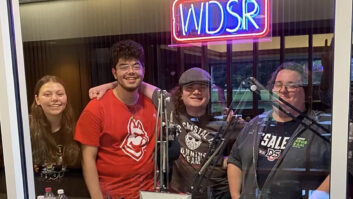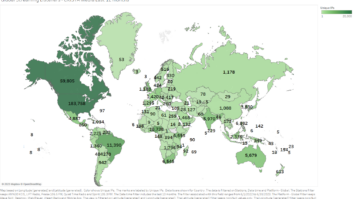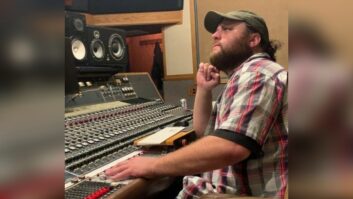
The fully equipped live studio is built around an Arrakis ARC-15 console. The studio supports full music or call-in shows, live-assist or unassisted automation. The studio can also be used to cut voice tracks or record other programming directly into the Digilink-HD system for scheduled playback at a later time. Like many station owners, I caught the broadcast bug thanks to college radio. That was followed by a brief on-air career that ended when the station flipped to an urban format and I got canned. So I got a real job selling radio time, and later television advertising, before moving on to a New York advertising agency. For the past 24 years I have owned a full-service video production company in St. Louis.
In early 2013, I had lunch with a college buddy who owned a group of small-market radio stations. We discussed the usual issues: the economy, taxes and how to find talented salespeople. Then he blew me away when he said: “But what really concerns me is how Internet radio growth might affect my stations’ value.”
He was right to worry. But I saw opportunity. With low cost of entry, no FCC and lower operating expenses, Internet radio could be in the emerging position that FM radio was in 1961, when the FCC approved stereo FM broadcasting.
That evening, I started researching and planning my Internet station. I quickly came up with a set of goals to make sure my station had the best competitive chance.
At the top of the list was the best technical platform I could afford, with audio quality as close to FM radio as possible. I did not want to build an Internet jukebox. I wanted to mix live presentation with automation. And I wanted to make money — this was not a hobby.
I studied playout and production systems along with encoding and audio processing. I interviewed three radio streaming services and compared their mobile apps and metadata capabilities. And I asked a ton of questions. One phrase I heard over and over again as I spelled out my demanding specifications was: “That really doesn’t matter because it is just Internet radio.”
Nobody I do business with today says that anymore.
I saw stream encoding, streaming servers and audio processing as my transmission system, so I started there. I never even considered hosting our own streaming server, for the same reason I got rid of the Microsoft Exchange Server and Real Video Server in my video operation many years ago. That job is best left to the pros sitting on a very large and redundant fiber Internet pipe.
DISTRIBUTION
I decided to partner with Securenet Systems Inc. to distribute the stream. They host thousands of streams in redundant data centers in California, Florida and France, and their streaming performance has been very good.
Where they really shine is in additional services. Securenet provides a smart and customizable Web player, with interactive features, social media feeds and a complete advertising display system. The monthly fees include free custom mobile apps for Apple and Android. Their U.S.-based customer service and sales teams seem to care whether we survive the first financially-draining years.
With the streaming provider chosen, I moved onto encoding and audio processing for the Internet. It is interesting to note that I received the same incorrect advice from almost every streaming provider when it came to encoding. Most said that all I needed was their free encoding app and any old Windows 7 clunker with an onboard integrated audio chipset or a cheap audio card with 1/8-inch I/O. That never made any sense to me. I won’t run my carefully crafted audio through a $3 audio card. Would any self-respecting engineer feed a transmitter with audio via an unbalanced audio consumer connector? No way!
I expected audio processing and encoding to be a difficult and confusing part of the puzzle. However, my first choice ended up being the best option. The radio stations I’ve worked for used Orban audio processing, so I started with them.
After lobbing questions at their sales and support folks I received a call from Greg Ogonowski, vice president of product development at Orban. Greg is basically one of the founding fathers of contemporary Internet radio. I learned that under his direction, Orban was the first to bring HE-AAC streaming to the Internet in 2002. They used the Coding Technologies HE-AAC encoders, formerly known as aacPlus. I don’t think it is an understatement to say that HE-AAC was as important to the growth of Internet radio as stereo was to FM radio back in 1960s. This codec has done more to make high-quality, streaming audio possible and viable than any other element in our plant.

Emily Stephens digitizes a vinyl record in the production studio. From the turntable the signal is routed through an Arrakis ARC-8 mixer via USB directly into the Digilink-HD automation system using the built-in DHD-Tools recording app on her workstation. Music files are encoded either as uncompressed WAV or 320 kbps MP3 files which will reside on the Digilink-HD play-out system where they will be available immediately for air. We chose Orban’s Opticodec PC to encode our two bitrate streams and Optimod PC for “major-market” Internet-specific audio processing. They work together and live in a standard PC with the Optimod PC card, eliminating the need for the $3 sound card in the PC. Orban’s PreCode technology manipulates aspects of our audio to minimize artifacts caused by low-bitrate codecs. An onboard mixer supports ad insertion with multiple analog and digital I/O options. Optimod PC’s multiband compressor includes program-adaptive dynamics and a crossover topology that works magic on our 45-year-old “retro-progressive” music content, with no readjustment from me. In fact, we are using an Optimod preset designed for my type of station by Ogonowski.
I receive many compliments on how great our station sounds — I don’t think they mean my musical selection. Almost 30 percent of our music content was dubbed from out-of-print vinyl LPs. It is not surprising that Ogonowski and Bob Orban were musicians before they were engineers. Audio processing is clearly both art and science.
LIVE STUDIO
The choice of an automation system was complicated and time-consuming. I did full-install demos on six systems. I started with a free open-source package called RadioDJ, then tried an inexpensive software package from New Zealand followed by a popular hobbyist program (clearly built by programmers who had never set foot inside a real radio station) and finally tested an impressive Linux package that was very tempting.
Ultimately, I chose Arrakis Systems Digilink-HD, which is scalable so it can support a single station or a multi-station group. The system is designed to compete with the high-end, heavyweight systems at the top of the food chain but at a competitive cost. A software utility called DHD-Tools is used for production tasks. Running from networked workstations, DHD-Tools allows me to control music scheduling, voice-tracking, segue editing, scheduled recordings and a great deal more. Functions can be operated remotely via a VPN. This is a capable system, admittedly targeted more at multi-station groups, not the entry-level Internet market.
Digilink-HD has great visual appeal. It looks like a broadcasting tool should look. No multiple windows opening and closing; controls are where they should be.
Many Internet station operators would be well-served by New~Wave, a feature-rich entry-level package from Arrakis. Comparing the systems, there is a big price difference. If you can live without some of the Digilink-HD high-end features, you can save a ton of money with New~Wave. I am taking advantage of a monthly program for Digilink-HD that includes full support.
Why Am I Doing This?
Can Internet radio ever make money? I point back to FM radio back in the 1960s. Internet radio is well ahead of FM back in its infancy. Recently, Media Daily News reported that 47 percent of Americans age 12 and over, an estimated 124 million people, said they have listened to online radio in the last month. Broadcast still rules, with 58 percent of the survey’s respondents saying they listen to AM/FM “almost all of the time” versus just 6 percent for online radio only. To me that sounds just like the AM versus FM in 1961.
But for now, online is at least in the game — we aren’t just “playing radio” anymore. Take a listen to “Progressive Rock for Vintage Rockers” at www.ourmusicalroots.com.
— John M. Stephens
Another one of our goals was to support broadcast-level live presentation, with in-studio interviews, live assist, full manual with CD and LP and live callers by phone or Skype. We stayed with Arrakis and chose their ARC-15 analog console, with 15 inputs, two output busses and real VU meters. On the cool stuff side, the board features an advanced telephone interface to an external hybrid — along with a Bluetooth channel that supports cellphones and even Bluetooth-equipped tablets and MP3 players. Arrakis offers combo pricing on automation with an audio board.
The ARC-15 features five mic inputs, four of which can be jumper-configured to additional balanced line-level inputs. The board also includes a USB interface that can eliminate the need for a professional audio card when taking a feed from both Windows and Apple devices.
To complete our live capability our studio includes Denon CD players, Stanton and Pro-Ject Debut Carbon turntables, Tascam CD and digital recorders, Grace Digital Internet radios, Tannoy and Bose monitor speakers, along with dbx and ART MP tube mic preamps.
With our location in St. Louis, and a retro-progressive music format, there was never any doubt that we would use only one brand and model of microphone, the Heil PR 40. If you have any questions about Heil Sound, ask any of the members of The Grateful Dead, The Who, Joe Walsh or Peter Frampton. Bob Heil basically invented the modern rock-and-roll concert sound system and along the way developed a number of excellent microphones.
That is what’s in our studio. We will have no technical excuses if we are not successful. Now I just have to find another 750 LPs from the late 1960s and early 1970s to round out our sound.
John M. Stephens is the president of Our Musical Roots in St. Louis. Reach him at [email protected].












